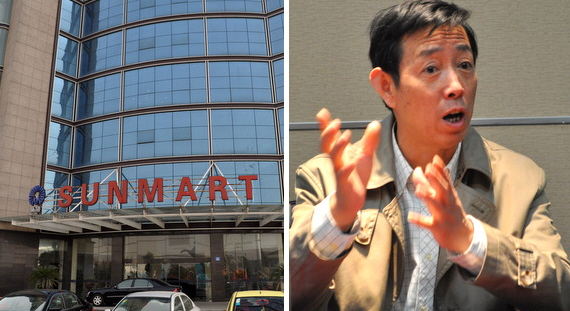

The Koreans were from the country's stock exchange and had travelled to interview Sunmart's management and check out its manufacturing operations in Jiangyin about 3 hours' drive from Shanghai.
The visit reflects the rigorous criteria for Korean listing aspirants, whose accounts are also required to be audited by a Top 4 auditing firm.

STX Pan Ocean had preceded Sunmart in 2007, two years after the shipping firm's primary listing in Singapore.
Sunmart, which listed in Singapore in 2007 at 25 cents a share, is China's largest manufacturer of spray pumps which are mainly used in the packaging of perfumes and pharmaceuticals. These pumps comprise more than a dozen tiny plastic parts precisely assembled by machines.
Sunmart exported 55% of its products to overseas OEM manufacturers who produce the consumer end-products for international brand names such as Avon, Mary Kay and Procter & Gamble.
Sunmart has over 2,000 customers in over 80 countries. By listing in Korea, Sunmart hopes to penetrate the thriving Korean cosmetics industry.
Sunmart will issue, and list, 200 million new shares at a price yet has to be announced. For illustration purposes, Sunmart said that based on a recent 16.5 cents a share, S$16.2 million (or 54% of the total raised) will be used to pay down bank borrowings.
Another S$12.0 million will be used for investment in plant and equipment (largely for increasing production of moulds used in manufacturing spray pumps) while the remaining S$1.571 million is for working capital.

Riding on an economic recovery, Sunmart reported a net profit of RMB 36.4 million for the first 9 months of this year, up 93.5% year on year.
The profit in each quarter was similar: RMB11.9m, RMB10.7m, and RMB12.9m, respectively.
Another positive: Its gross profit margin was 31.8%, compared to 25.2% in 9M2009.
Revenue for 9M2010 rose 39.6% year on year to RMB246.3 million.
A negative was the operating cashflow which was negative RMB26.2 million due to an increase in inventories of RMB 13.3 million and a RMB 43.7 million increase in other receivables (deposits paid to suppliers for raw materials and contractors for the purchase of new equipment).
The main raw material that Sunmart uses is plastic resins, a commodity whose price is linked to the price of crude oil.
As the business has recovered strongly from the global financial crisis, it is set to be a steady grower, said Sunmart chairman Sun Bingzhong.
It could even sizzle. "We now have only a small market of the business of the major cosmetic brands. We aim to get more, as the OEMs turn to us for supplies at a lower cost but good quality," said Mr Sun.
At the last traded price of 19 cents, Sunmart's shares sell at an estimated 8X this year's earnings. There appears to be upside potential for the share price in Singapore as comparable companies in Korea trade at 12-15x PE.

The potential upside for the shares stems from the fact that any Sunmart share can be traded on both stock exchanges, a flexibility not available to Singapore-listed shares listed as TDRs in Taiwan. This feature will ensure there is minimal valuation gap between Sunmart’s shares listed on both exchanges.
The flip side of the dual listing is the 200 m shares that Sunmart will issue, as they will bring about a significant dilution for existing shareholders of its current 402 m share capital.
The chairman himself will see his direct and deemed holding of 70.7% shrink to 47.21% but he sees positives, including a higher valuation for the company's shares in Singapore, and raising Sunmart's profile in the Korean cosmetics industry.
"The dual listing will also give us funds to repay loans which are charging 8% a year. By saving on interest expenses, our net profit margin will improve," he said. “The funds will also enable us to expand our business.”
Recent stories:
CHINA GAOXIAN, COMBINE WILL, SUNMART: Heading for Korea listing
SUNMART's dual-listing (in Korea) news that the market has missed
SUNMART: 'Why I became a substantial shareholder'





